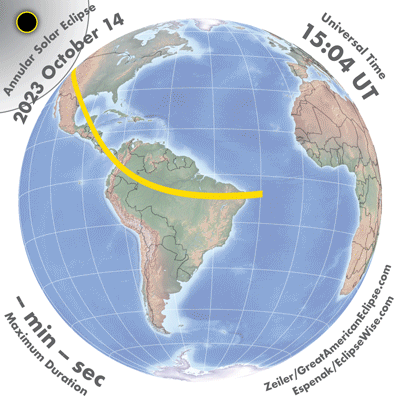ANNULAR ECLIPSE 2023: SATURDAY OCTOBER 14
Those living and traveling into this path of annularity will see an annular solar eclipse. An annular eclipse is where a ‘ring’ of the Sun’s brightness will remain visible, depending on your location. This type of solar eclipse is not as spectacular or awe-inspiring as a total solar eclipse, where the Sun is completely covered and the Moon’s central shadow rushes in creating darkness. Solar filters are required throughout to protect your eyes. Dimming of the light and a reduction in temperature is noticeable, and it will be an enjoyable experience.
Path overview
The path of annularity first makes landfall in the US, and includes the states of Oregon, Nevada, Utah, New Mexico, and Texas, briefly grazing the states of California, Idaho, Colorado, and Arizona. The path then continues through the Yucatan peninsula in Mexico, then across Central America through Belize, Guatemala, Honduras, Nicaragua, Costa Rica, and Panama. The path then makes landfall again into South America, crossing over Colombia and Brazil.
Regions that will see a partial eclipse include North America, South America, West Africa, the Pacific, Atlantic, and Arctic.
This solar eclipse is considered to be the first of a ‘double hitter’ for North America, and is expected to be of much greater interest to the general population than an annular eclipse usually is. The main show of this ‘double hitter’ occurs just six months later, when a total solar eclipse will be visible on April 8, 2024.

Unique path features
- The path of annularity for this eclipse occurs over huge population areas in the US, before continuing into Central then South America
- The point of maximum eclipse is in the Caribbean Sea off the coast of Nicaragua and Costa Rica, with annularity lasting 5 minutes 17 seconds
- The path is 116 miles wide at the point of maximum eclipse
- The best weather prospects will be in the US Southwest, and toward the end of the path near the Brazilian Sertão
- This path intersects areas in Oregon that played host to the 2017 total eclipse
- The path also intersects areas in Texas that will play host to the 2024 total eclipse.
Special planning considerations
- This annular solar eclipse will occur 177 days before the next total solar eclipse and therefore may generate more interest than usual
- Communities in the path of annularity in Central Texas that also intersect with the 2024 path of totality six months later will require “double planning”. Media interest will be higher, and impacted communities should maximize this very rare opportunity.
- Communities in the path of annularity in Oregon, who were also in the 2017 path of totality, may also experience higher visitation than other locations
- Solar filters must be worn even during annularity, as parts of the Sun will always remain visible
- Communities in Central and South America may experience an increase in international visitation, especially where the weather is more favorable in Brazil.
The first of the North American eclipse ‘double hitter’
The “Great American Eclipse” of 2017 introduced solar eclipses to the general American population for the first time in over 39 years. With over 88% of the American population viewing the solar eclipse either directly or indirectly, interest has never been greater.
The map to the right shows the path of totality for the 2017 and 2024 total solar eclipses, along with the path of annularity for the 2023 solar eclipse. The areas along the path of the 2023 annular eclipse that intersect with these total eclipses are likely to experience significant media interest in 2023, especially in Texas where some regions are planning for two solar eclipses to occur in the space of 6 months.
The American Astronomical Society (AAS) Solar Eclipse Task Force was initially set up in 2014 to help coordinate national preparations for the “Great American Eclipse” of August 21, 2017. Following the 2017 total solar eclipse, the Solar Eclipse Task Force shifted focus toward preparations for the two solar eclipses that will be visible across North America in the near future – the annular eclipse in 2023; and the total solar eclipse in 2024. The task force has been meeting at least monthly for the past several years via Zoom. Planning workshops have been held virtually throughout the pandemic, with a more recent return to in-person eclipse planning workshops from the end of 2022.
Several working groups have been formed to guide various aspects of eclipse planning for the upcoming annular and total solar eclipses of 2023 and 2024, including working groups for Eye Safety, Web & Social Media, Local Planning, National Planning, Formal Education, Informal Education and Public Engagement, and Media Engagement.


HELPFUL LINKS
The following are links to external sites and are my recommendations for further information about the 2023 annular solar eclipse.
Start here at the AAS official eclipse site for authoritative information. Detailed site with extensive links and resources.
Eclipsophile.com provides detailed analysis of the weather along the path of totality and annularity for every solar eclipse – an essential resource. Run by eclipse chaser Jay Anderson, a Canadian meteorologist.
Eclipsewise.com is the authoritative source for lunar and solar eclipse predictions and information. Run by eclipse chaser Fred Espenak, a retired NASA astrophysicist also known as ‘Mr Eclipse’.
SolarEclipsesGoogleMaps is a feature-laden interactive GoogleMap that allows for detailed exploration of the path of totality future or past solar eclipses. Prepare to spend hours using this tool. Run by eclipse chaser Xavier Jubier, a French IT specialist.
Check out this very cool eclipse simulator tool. Pick your location (within OR outside the path) and play with the simulator to get a good feel for what to expect. Run by eclipse chaser Dan McGlaun.
The fully endorsed, official eye safety guidance used internationally to instruct HOW to view a solar eclipse safely can be found on this authoritative site. Anything that contradicts this information is outdated and wrong.
An extensive site with facts, figures, gorgeous maps, resources and an eclipse-related shop. By Michael Zeiler, eclipse chasing cartographer. Start exploring here and get lost for hours.
I am an active member of the AAS Solar Eclipse Task Force, and circulate planning guidance, run workshops, deliver tailored Zoom consultations, detailed strategy plans, community visits, tailored content. Get in touch if you need to know more.
Start here to explore and see what is happening in various countries, states and regions.
